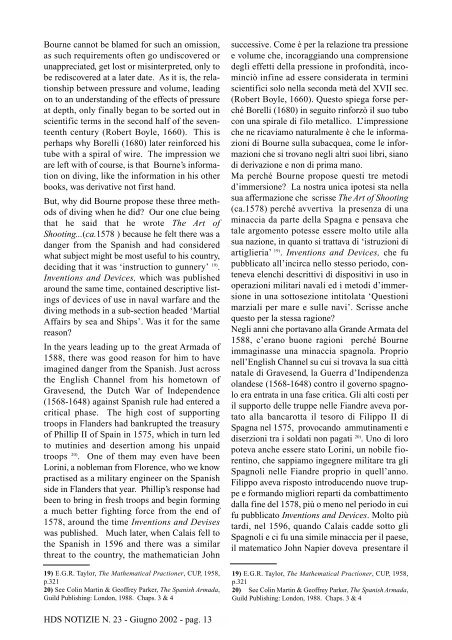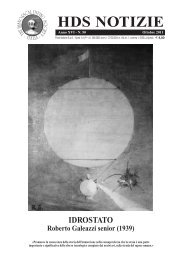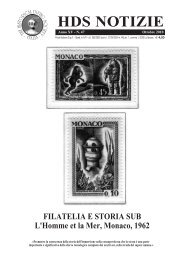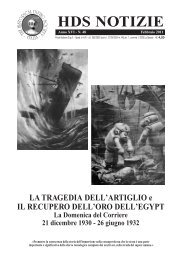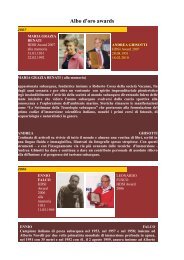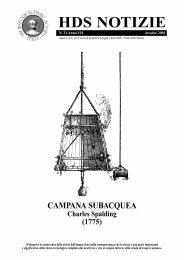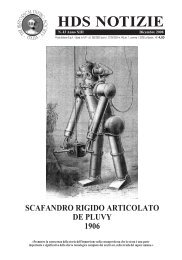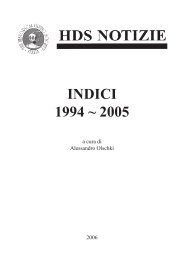hds internet - The Historical Diving Society Italia
hds internet - The Historical Diving Society Italia
hds internet - The Historical Diving Society Italia
Create successful ePaper yourself
Turn your PDF publications into a flip-book with our unique Google optimized e-Paper software.
Bourne cannot be blamed for such an omission,<br />
as such requirements often go undiscovered or<br />
unappreciated, get lost or misinterpreted, only to<br />
be rediscovered at a later date. As it is, the relationship<br />
between pressure and volume, leading<br />
on to an understanding of the effects of pressure<br />
at depth, only finally began to be sorted out in<br />
scientific terms in the second half of the seventeenth<br />
century (Robert Boyle, 1660). This is<br />
perhaps why Borelli (1680) later reinforced his<br />
tube with a spiral of wire. <strong>The</strong> impression we<br />
are left with of course, is that Bourne’s information<br />
on diving, like the information in his other<br />
books, was derivative not first hand.<br />
But, why did Bourne propose these three methods<br />
of diving when he did? Our one clue being<br />
that he said that he wrote <strong>The</strong> Art of<br />
Shooting...(ca.1578 ) because he felt there was a<br />
danger from the Spanish and had considered<br />
what subject might be most useful to his country,<br />
deciding that it was ‘instruction to gunnery’ 19) .<br />
Inventions and Devices, which was published<br />
around the same time, contained descriptive listings<br />
of devices of use in naval warfare and the<br />
diving methods in a sub-section headed ‘Martial<br />
Affairs by sea and Ships’. Was it for the same<br />
reason?<br />
In the years leading up to the great Armada of<br />
1588, there was good reason for him to have<br />
imagined danger from the Spanish. Just across<br />
the English Channel from his hometown of<br />
Gravesend, the Dutch War of Independence<br />
(1568-1648) against Spanish rule had entered a<br />
critical phase. <strong>The</strong> high cost of supporting<br />
troops in Flanders had bankrupted the treasury<br />
of Phillip II of Spain in 1575, which in turn led<br />
to mutinies and desertion among his unpaid<br />
troops 20) . One of them may even have been<br />
Lorini, a nobleman from Florence, who we know<br />
practised as a military engineer on the Spanish<br />
side in Flanders that year. Phillip’s response had<br />
been to bring in fresh troops and begin forming<br />
a much better fighting force from the end of<br />
1578, around the time Inventions and Devises<br />
was published. Much later, when Calais fell to<br />
the Spanish in 1596 and there was a similar<br />
threat to the country, the mathematician John<br />
19) E.G.R. Taylor, <strong>The</strong> Mathematical Practioner, CUP, 1958,<br />
p.321<br />
20) See Colin Martin & Geoffrey Parker, <strong>The</strong> Spanish Armada,<br />
Guild Publishing: London, 1988. Chaps. 3 & 4<br />
HDS NOTIZIE N. 23 - Giugno 2002 - pag. 13<br />
successive. Come è per la relazione tra pressione<br />
e volume che, incoraggiando una comprensione<br />
degli effetti della pressione in profondità, incominciò<br />
infine ad essere considerata in termini<br />
scientifici solo nella seconda metà del XVII sec.<br />
(Robert Boyle, 1660). Questo spiega forse perché<br />
Borelli (1680) in seguito rinforzò il suo tubo<br />
con una spirale di filo metallico. L’impressione<br />
che ne ricaviamo naturalmente è che le informazioni<br />
di Bourne sulla subacquea, come le informazioni<br />
che si trovano negli altri suoi libri, siano<br />
di derivazione e non di prima mano.<br />
Ma perché Bourne propose questi tre metodi<br />
d’immersione? La nostra unica ipotesi sta nella<br />
sua affermazione che scrisse <strong>The</strong> Art of Shooting<br />
(ca.1578) perché avvertiva la presenza di una<br />
minaccia da parte della Spagna e pensava che<br />
tale argomento potesse essere molto utile alla<br />
sua nazione, in quanto si trattava di ‘istruzioni di<br />
artiglieria’ 19) . Inventions and Devices, che fu<br />
pubblicato all’incirca nello stesso periodo, conteneva<br />
elenchi descrittivi di dispositivi in uso in<br />
operazioni militari navali ed i metodi d’immersione<br />
in una sottosezione intitolata ‘Questioni<br />
marziali per mare e sulle navi’. Scrisse anche<br />
questo per la stessa ragione?<br />
Negli anni che portavano alla Grande Armata del<br />
1588, c’erano buone ragioni perché Bourne<br />
immaginasse una minaccia spagnola. Proprio<br />
nell’English Channel su cui si trovava la sua città<br />
natale di Gravesend, la Guerra d’Indipendenza<br />
olandese (1568-1648) contro il governo spagnolo<br />
era entrata in una fase critica. Gli alti costi per<br />
il supporto delle truppe nelle Fiandre aveva portato<br />
alla bancarotta il tesoro di Filippo II di<br />
Spagna nel 1575, provocando ammutinamenti e<br />
diserzioni tra i soldati non pagati 20) . Uno di loro<br />
poteva anche essere stato Lorini, un nobile fiorentino,<br />
che sappiamo ingegnere militare tra gli<br />
Spagnoli nelle Fiandre proprio in quell’anno.<br />
Filippo aveva risposto introducendo nuove truppe<br />
e formando migliori reparti da combattimento<br />
dalla fine del 1578, più o meno nel periodo in cui<br />
fu pubblicato Inventions and Devices. Molto più<br />
tardi, nel 1596, quando Calais cadde sotto gli<br />
Spagnoli e ci fu una simile minaccia per il paese,<br />
il matematico John Napier doveva presentare il<br />
19) E.G.R. Taylor, <strong>The</strong> Mathematical Practioner, CUP, 1958,<br />
p.321<br />
20) See Colin Martin & Geoffrey Parker, <strong>The</strong> Spanish Armada,<br />
Guild Publishing: London, 1988. Chaps. 3 & 4


